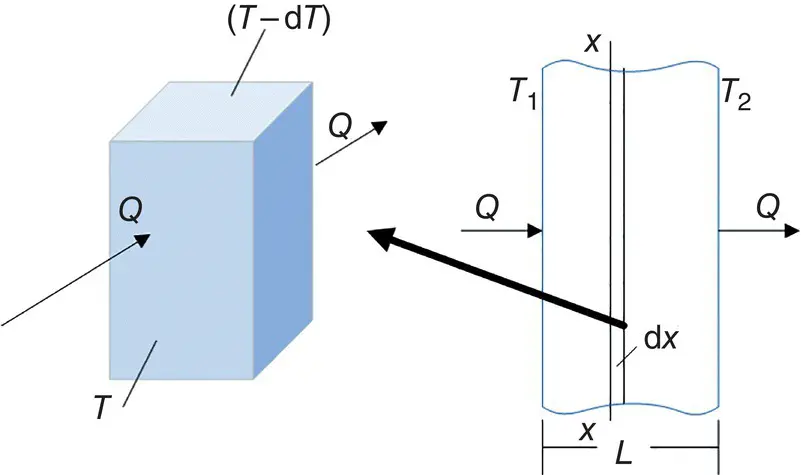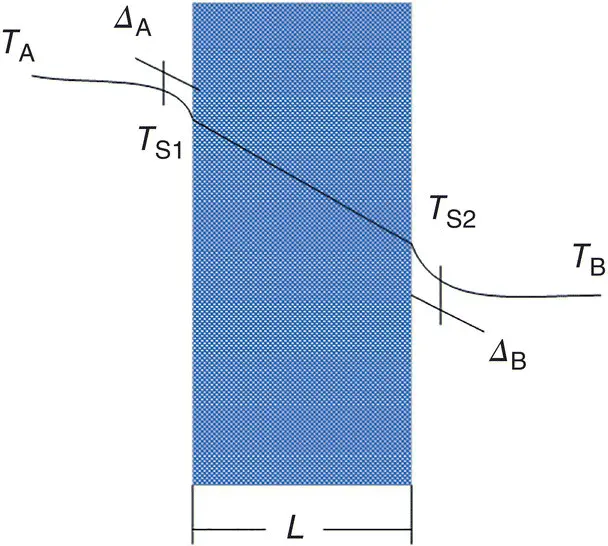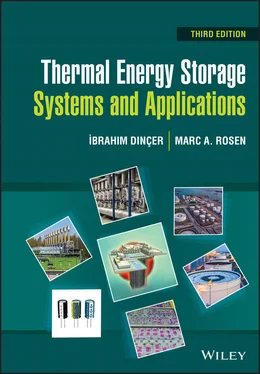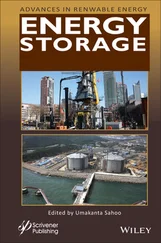Figure 1.15presents an illustration of Fourier's law of heat conduction. Here, a thin slab object of thickness d x and surface area F has one face at a temperature T and the other at a lower temperature ( T − d T ). Heat flows from the high‐temperature side to the low‐temperature side, with a temperature change d T in the direction of the heat flow. Therefore, under Fourier's law we obtain the heat transfer as
(1.83) 

Figure 1.15 Conduction in a slab (a) and in a thin slice of the slab (b).
Here, we have a term thermal conductivity , k , of the object, which can be defined as the heat flow per unit area per unit time when the temperature decreases by one degree over a unit distance.
The SI units of thermal conductivity are usually W/m°C or W/m K.
Integrating Eq. (1.83)from T 1to T 2for d T and 0 to L for d x yields
(1.84) 
Equation (1.84)can be solved when the variation of thermal conductivity with temperature is known. For most solids, thermal conductivity values are approximately constant over a broad range of temperatures, and can be taken as constants.
1.6.2 Convection Heat Transfer
Convection is the heat transfer mode that occurs within a fluid by mixing one portion of the fluid with another. Convection heat transfer may be classified according to the nature of the flow. When the flow is caused by some mechanical or external means such as a fan, a pump, or atmospheric wind, it is called forced convection . On the other hand, for natural ( free ) convection, the flow is induced by buoyancy forces in the fluid that arise from density variations caused by temperature variations in the fluid. For example, when a hot object is exposed to the atmosphere, natural convection occurs, whereas in a cold place with a fan‐driven air flow, forced‐convection heat transfer takes place between air flow and the object subject to this flow. The transfer of heat through solid objects is by conduction alone, whereas the heat transfer from a solid surface to a liquid or gas takes place partly by conduction and partly by convection. Whenever there is an appreciable movement of the gas or liquid, the heat transfer by conduction in the gas or liquid becomes negligibly small when compared with the heat transfer by convection. However, there is always a thin boundary layer of fluid on a surface, and through this thin film the heat is transferred by conduction. The convection heat transfer occurring within a fluid is due to the combined effects of conduction and bulk fluid motion. In general, the heat that is transferred is the sensible or internal thermal heat of the fluid. However, there are convection processes for which there is also latent heat exchange, which is generally associated with a phase change between the liquid and vapor states of the fluid.

Figure 1.16 A wall subject to convection heat transfer on both sides.
(b) Newton's Law of Cooling
Newton's law of cooling states that the heat transfer from a solid surface to a fluid is proportional to the difference between the surface and fluid temperatures, and the surface area. This is a particular type of convection heat transfer, and is expressed as
(1.85) 
where h is referred to as the convection heat transfer coefficient (the heat transfer coefficient , the film coefficient , or the film conductance ). It encompasses all effects that influence the convection mode and depends on conditions in the boundary layer, which is affected by factors such as surface geometry, the nature of the fluid motion, and thermal and physical properties ( Figure 1.16).
In Eq. (1.85), a radiation term is not included. The calculation of radiation heat transfer is discussed later. In many heat transfer problems, the radiation effect on the total heat transfer is negligible compared with the heat transferred by conduction and convection from a surface to a fluid. When the surface temperature is high, or when the surface loses little heat by natural convection, then the heat transfer due to radiation is often of a similar magnitude to that lost by convection.
To better understand Newton's law of cooling, consider the heat transfer from a high‐temperature fluid A to a low‐temperature fluid B through a wall of thickness x( Figure 1.16). In fluid A, the temperature decreases rapidly from T Ato T s1in the region of the wall, and similarly in fluid B from T s2to T B. In most cases, the fluid temperature is approximately constant throughout its bulk, apart from a thin film (Δ Aor Δ B) of fluid near each solid surface. The heat transfer per unit surface area from fluid A to the wall and that from the wall to fluid B can be expressed as
(1.86) 
(1.87) 
Also, the heat transfer in thin films is by conduction only, as given below:
(1.88) 
(1.89) 
Equating Eqs. (1.86)– (1.89), the convection heat transfer coefficients can be found to be h A= k A/Δ A, and h B= k B/Δ B. Thus, the heat transfer in the wall per unit surface area becomes
(1.90) 
For the case of steady‐state heat transfer, Eq. (1.86)is equal to Eq. (1.87), and hence to Eq. (1.90):
(1.91) 
which yields
(1.92) 
An analogy can be made with Eq. (1.85), allowing Eq. (1.92)to become
Читать дальше
























